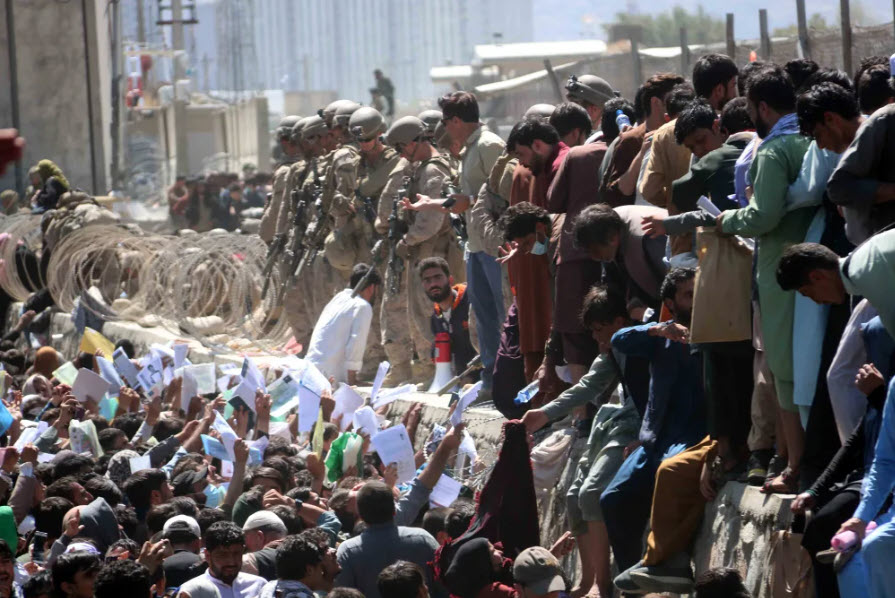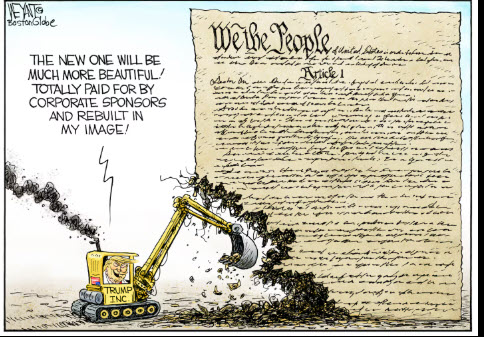
Says He Inherited Biden’s Inflation. What About His Own Contribution?

Over ten months into his second term, President Trump has paid no attention to fulfilling the campaign pledge that is believed to have won him the election: the promise to bring down inflation and prices.
Until this week. Perhaps urged by aides that “affordability” has become the hot button issue for America’s families struggling to pay their bills, he staged a rally in Pennsylvania's Pocono Mountains. He had previously said, “The word affordability is a con job by the Democrats” and “a Democratic hoax”. But at the rally he was expected to execute a volte-face and acknowledge that, yes, there is a problem, and to announce a vigorous plan to battle high and rising costs.
But he didn’t. As someone for whom there’s never been a moment in his life when he’s lacked for money, he cannot make the transition into the lives of ordinary Americans. He fraternizes with other billionaires, including Treasury Secretary Scott Bessent, who of like mind said on “Face the Nation” last Sunday, ”The American people don't know how good they have it.”
So Trump continued to spoof the word ‘affordability’ at the rally:
”I say it and I said it the other day and a lot of people misinterpret it, 'Oh, he doesn't realize prices are high'. Prices are coming down very substantially, but they have a new word — you know, they always have a hoax — the new word is ‘affordability’."
…always said in a mocking tone. Behind him, a banner the width of the stage and printed cards held up by the audience proclaimed “Lower Prices” and “Higher Paychecks” as the crowd chanted “Four More Years”.
A quick run-through of what you probably already know to get to the larger point of today’s piece:
Prices are not "coming down very… Read More »
After National Guard Killing, Trump Doubles Down on Afghan Betrayal
Biden’s disastrous Afghanistan withdrawal left thousands behind in the original betrayalWithout any of the careful deliberation we should expect from a president, Donald Trump instantly reacted to the National Guard shootings that killed a young woman and left another soldier in critical condition with a tweet:
“I will permanently pause immigration from all Third World Countries to allow the U.S. system to fully recover, terminate all of the millions of Biden illegal admissions, including those signed by Sleepy Joe Biden’s Autopen.”
He continued elsewhere that he would “end all Federal benefits and subsidies to noncitizens of our Country and denaturalize migrants who undermine domestic tranquility.”
U.S. Citizenship and Immigration Services announced,
“Effective immediately, processing of all immigration requests relating to Afghan nationals is stopped indefinitely pending further review of security and vetting protocols.”
At the direction of the president, the agency is to re-examine all people from 19 countries including Afghanistan who hold green card work permits.

Crowd below offering clearance papers to American troops above in hopes of boarding planes to U.S. at Kabul Airport August 28, 2021.
Trump on his Truth Social pledged… Read More »
The Rightwing’s Chokehold on American Media Is Tightening »
Sep 26 2025Many voices across America during the past week insisted on the safeguarding of unabridged free speech after the cancellation of Jimmy Kimmel’s late-night show and after no less than the attorney general, Pam Bondi, 
declaring that the Justice Department will “will absolutely target you, go after you, if you are targeting anyone with hate speech”. That’s the very speech the amendment protects. “Pam Bondi Needs a Free Speech Tutorial” was the title of a Wall…
Read More »
"I subscribe to Let's Fix This Country (http://letsfixthiscountry.org) for their reporting and think you might want to subscribe too."
We rely entirely on word of mouth. Yours would be greatly appreciated.
news briefs
Murdering the Shipwrecked and Other News Items
Dec 1 2025
This isn’t meant to be a newspaper, but to ignore the torrent of news that bombards us daily runs the risk of seeming clueless. So here are a few items from the last ten days or so to show we've stayed tuned:
Washington post says hegseth ordered war crime
As surveillance aircraft closed on the first alleged drug boat that the U.S. was about to destroy on September 2nd, “The order was to kill everybody” given verbally by Defense Secretary Pete Hegseth according to two involved in the operation, The Washington Post reported Friday. When two survivors were spotted clinging to the burning wreckage, “The Special Operations commander overseeing the attack… ordered a second strike to comply with Hegseth’s instructions” and “the two men were blown apart in the water” that, according to a person who had seen the second video not released to the media, “people would be horrified” to see.
Hegseth dismissed the Post’s investigation as ”fabricated, inflammatory, and derogatory reporting”.
There were eleven people on that September 2nd boat and the next day Hegseth said on Fox News:
"I watched it live. We knew exactly who was in that boat. We knew exactly what they were doing. And we knew exactly who they represented and that was …
Read More »
This isn’t meant to be a newspaper, but to ignore the torrent of news that bombards us daily runs the risk of seeming clueless. So here are a few items from the last ten days or so to show we've stayed tuned:
Washington post says hegseth ordered war crimeAs surveillance aircraft closed on the first alleged drug boat that the U.S. was about to destroy on September 2nd, “The order was to kill everybody” given verbally by Defense Secretary Pete Hegseth according to two involved in the operation, The Washington Post reported Friday. When two survivors were spotted clinging to the burning wreckage, “The Special Operations commander overseeing the attack… ordered a second strike to comply with Hegseth’s instructions” and “the two men were blown apart in the water” that, according to a person who had seen the second video not released to the media, “people would be horrified” to see.
Hegseth dismissed the Post’s investigation as ”fabricated, inflammatory, and derogatory reporting”.
There were eleven people on that September 2nd boat and the next day Hegseth said on Fox News:
"I watched it live. We knew exactly who was in that boat. We knew exactly what they were doing. And we knew exactly who they represented and that was … Read More »
morality
What Explains the Sadism of Trump World?
Nov 21 2025
The Trump administration’s battle to withhold food aid, especially with so many going without a paycheck during the government shutdown, made for yet another ugly display of a theme that runs throughout his presidency: cruelty. “We have the greatest economy we’ve ever had", Trump says, but he sees no further than corporate America and the booming stock market and dismisses the difficulties people have in paying their bills. “I don’t know that they are saying that. I think polls are fake”.

Some 42 million families rely on financial assistance provided by SNAP (Supplemental Food Assistance Program, formerly referred to as food stamps) to pay for food, yet during the shutdown, the Trump administration refused to draw upon $5.6 billion set aside for just such emergencies. That was deliberate cruelty.
Two federal judges ordered the administration to tap the contingency fund, but the Department of Agriculture, which administers SNAP, claimed the funds were not "legally available" even though Congress had created the fund specifically for SNAP and just such emergencies as the shutdown. The $5.6 billion wasn't enough to fully fund the $8 billion outlay needed for November was the next excuse, despite the White House showing little difficulty shuffling funds around for other purposes, such as paychecks for the military and the agencies conducting mass deportation.
To the end, the Trump administration defied the district…
Read More »
The Trump administration’s battle to withhold food aid, especially with so many going without a paycheck during the government shutdown, made for yet another ugly display of a theme that runs throughout his presidency: cruelty. “We have the greatest economy we’ve ever had", Trump says, but he sees no further than corporate America and the booming stock market and dismisses the difficulties people have in paying their bills. “I don’t know that they are saying that. I think polls are fake”.

Some 42 million families rely on financial assistance provided by SNAP (Supplemental Food Assistance Program, formerly referred to as food stamps) to pay for food, yet during the shutdown, the Trump administration refused to draw upon $5.6 billion set aside for just such emergencies. That was deliberate cruelty.
Two federal judges ordered the administration to tap the contingency fund, but the Department of Agriculture, which administers SNAP, claimed the funds were not "legally available" even though Congress had created the fund specifically for SNAP and just such emergencies as the shutdown. The $5.6 billion wasn't enough to fully fund the $8 billion outlay needed for November was the next excuse, despite the White House showing little difficulty shuffling funds around for other purposes, such as paychecks for the military and the agencies conducting mass deportation.
To the end, the Trump administration defied the district… Read More »
With Time’s Passage Can We Now Speak Openly About Charlie Kirk? »
Nov 8 2025The months since Charlie Kirk's assassinations have seen opposite effects, a surge in growth as more school groups apply to form chapters and more young people join, while critics finally feel free to expose Kirk's bigotry and homophobia without fear of losing their jobs in the great anti-free speech pogrom that followed his death.
Andrew Kolvet, who has taken Kirk's place as the host of "The Charlie Kirk Show," a national radio program and podcast followed by some two million listeners every week, says Turning Point has received some 140,000… Read More »
